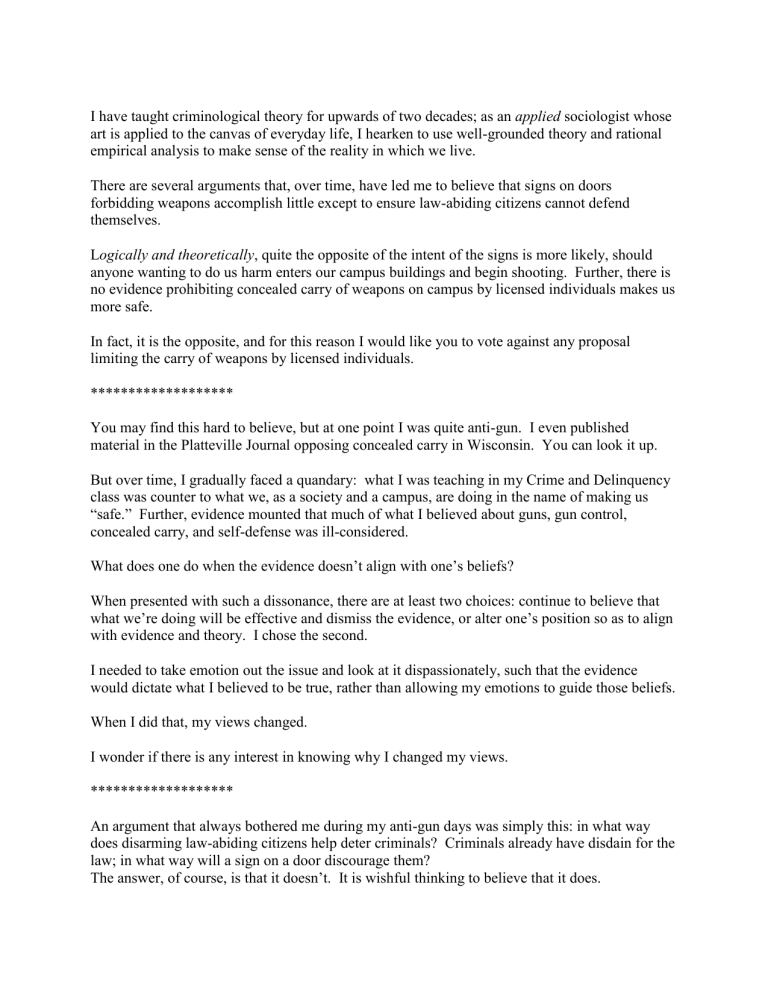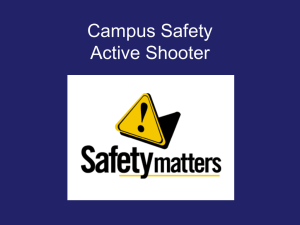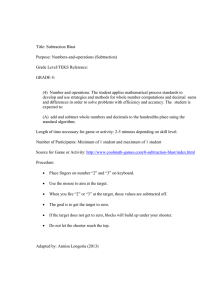applied art is applied to the canvas of everyday life, I...

I have taught criminological theory for upwards of two decades; as an applied sociologist whose art is applied to the canvas of everyday life, I hearken to use well-grounded theory and rational empirical analysis to make sense of the reality in which we live.
There are several arguments that, over time, have led me to believe that signs on doors forbidding weapons accomplish little except to ensure law-abiding citizens cannot defend themselves.
L ogically and theoretically , quite the opposite of the intent of the signs is more likely, should anyone wanting to do us harm enters our campus buildings and begin shooting. Further, there is no evidence prohibiting concealed carry of weapons on campus by licensed individuals makes us more safe.
In fact, it is the opposite, and for this reason I would like you to vote against any proposal limiting the carry of weapons by licensed individuals.
*******************
You may find this hard to believe, but at one point I was quite anti-gun. I even published material in the Platteville Journal opposing concealed carry in Wisconsin. You can look it up.
But over time, I gradually faced a quandary: what I was teaching in my Crime and Delinquency class was counter to what we, as a society and a campus, are doing in the name of making us
“safe.” Further, evidence mounted that much of what I believed about guns, gun control, concealed carry, and self-defense was ill-considered.
What does one do when the evidence doesn’t align with one’s beliefs?
When presented with such a dissonance, there are at least two choices: continue to believe that what we’re doing will be effective and dismiss the evidence, or alter one’s position so as to align with evidence and theory. I chose the second.
I needed to take emotion out the issue and look at it dispassionately, such that the evidence would dictate what I believed to be true, rather than allowing my emotions to guide those beliefs.
When I did that, my views changed.
I wonder if there is any interest in knowing why I changed my views.
*******************
An argument that always bothered me during my anti-gun days was simply this: in what way does disarming law-abiding citizens help deter criminals? Criminals already have disdain for the law; in what way will a sign on a door discourage them?
The answer, of course, is that it doesn’t. It is wishful thinking to believe that it does.
If someone plans to engage in a violent shooting, no sign will stop that person. It will, however, help them to identify a place or places where it is unlikely those present can offer credible opposition.
Why? The answer lies in Rationality/Opportunity Theory. There are several manifestations of this theory, but one relatively straightforward description holds that for a crime to occur three conditions are necessary: a motivated offender, a suitable target, and a lack of capable guardians.
Do we, while “prohibiting” weapons on campus, present the conditions necessary for a mass shooting to occur? We do, so let’s use this theory to understand why.
Motivated offender. Someone who intends to kill others is already motivated. Some areas of prevention focus on how to identify and alter such motivations, but in our case here, the first criterion for a crime to occur is met.
Suitable target. Just as a burglar chooses targets likely to result in significant loot, a room or building full of people with no ability to defend themselves is a suitable target for a shooter.
Further, presuming that law-abiding citizens would not break the law and carry weapons inside such buildings, the target is even more suitable given the third criterion:
Lack of capable guardians . Normally people take this to be law enforcement in whatever guises it might come, in our case campus police and possibly Platteville police or Grant County deputies. But it also can include those who can defend themselves.
We typically have no more than 2 or 3 campus police officers on campus, the Platteville police are minutes away, and by the time anyone could respond–unless blind luck had such officers present at the time–the shooter will have done his damage.
There’s an old saying some like to use with regard to police response: when seconds count, the police are minutes away. I have had police officers tell me this, because obviously the police cannot be everywhere at once.
Our current environment allows for the second and third criteria necessary for a crime to be committed: a suitable target and a lack of capable guardians. It is only the luck that a motivated offender hasn’t decided to take advantage of a defenseless campus population that we haven’t had a tragedy.
********************
If the police are minutes away, what can we, as potential victims, do?
We can alter the conditions that allow the second and third criteria for a crime to occur: create doubt that there is a “suitable target” and provide for others who could offer resistance to the shooter, i.e., those who are properly licensed to carry concealed weapons.
What’s important here is perception ; people act not on the basis of reality, but on their perception of reality. It has always been that way.
We can, if we choose to own our prospects, alter the perception that an active shooter would have of an otherwise defenseless victim population.
********************
I would not characterize a shooter as “rational” in the normal sense of the word; they certainly are ill, but within that pathology lies an intent to apply their will. Psychologists can tell you that people in the grips of mental illness do not behave irrationally all the time, nor that they cannot distinguish between cause and effect. The point is that the shooter’s goals are irrational, not that they cannot determine how to bring those goals about.
Generally, when we set about to do something, we’d like there to be a high probability we can be successful. We will arrange circumstances such that we have the best chance of success.
When we think we can’t succeed, we either change the circumstances or wait for a better opportunity.
Here’s an example. Suppose you are a driver with a lead foot, i.e., you exceed the speed limit on a regular basis. If you’re like most drivers, you do not want to be stopped by a police officer and handed a citation.
.
You are driving on Business 151 heading from Culvers toward Menards. As you crest the hill, you notice a police officer in a marked car doing traffic control with radar. Your heart leaps for a second, and if you’re lucky, you don’t exceed whatever speed the officer uses to stop speeders.
Whew!
The next day, you’re traveling the same road, in the same direction, and you recall the speed trap the previous day. What do you do? If you’re like most, you slow to the speed limit, even though you don’t know whether or not there’s an officer on top of that hill with a radar gun. In other words, the possibility of failure –your goal is to avoid tickets–causes you to alter your behavior and slow down.
This is exactly the kind of situation which does not exist on a campus forbidding weapons.
There is no reason for a potential shooter to assume anyone can defend themselves. It is, if crudely put, open season on defenseless victims.
****************
But what would happen if we allowed concealed carry on campus? Undoubtedly, some faculty and older students would carry.
No 18-year-old first year student would be legally carrying concealed–one cannot get a concealed carry permit until one turns 21.
What would a shooter conclude about the “suitability” of their target when it isn’t clear that the potential victims are defenseless? There is doubt as to success–just as you, as a speeder cresting the hill on Hwy 151, aren’t sure whether there’s a police car doing traffic control.
********************
There really are two issues here which are easily conflated. One is whether we are likely to have shooting on campus by a concealed-carry holder.
The other is our ability to respond to an active shooter. Preventing licensed concealed carry on campus not only makes us a more likely target for such an event, it eliminates the possibility that such a concealed carry holder might either stop an active shooter or slow that shooter down allowing for police to arrive.
There are really two different issues here, and as we discuss this we should endeavor to acknowledge that and identify the specific situation to which we are referring.
************************
I’ve heard some say “I don’t want to carry a gun on campus.” Nothing in my view of this requires any particular individual to carry a gun.
In fact, I believe those who are not comfortable doing so, or are not capable of effectively using a gun, should not carry.
I certainly don’t want someone carrying a gun who isn’t reasonably proficient with it–and that includes understanding the importance of the 4 rules of firearm safety as well as the conditions under which they may legally deploy a firearm.
We don’t need everyone to carry a firearm–we just need, as they say in the movies, “reasonable doubt” as to who and how many are carrying, enough that the shooter has to reconsider his approach.
************************
Now, some might note, with some justification, that such a shooter would simply choose another target if this one is too hard. That phenomenon is known as displacement, i.e., a shifting of target, place, time or method of criminal behavior. While that may be true, it simply begs this question: if one is concerned about displacement are we, therefore, offering ourselves up as bait which will attract a shooter who otherwise would harm different people instead of ourselves?
*************************
Some also have noted their concern about discussing student grades with an armed student. A student who brandishes a weapon in a discussion with a professor can be dealt with under the law. The fact that I might carry a weapon doesn’t give me the right to use it to intimidate others.
Such a student should be reported to the police for investigation and eventual adjudication.
It has also been suggested that in classes with strong debate, students with concealed carry weapons might be inclined to use them as an alternative to speech.
I think this is unfair to our students, who are characterized by some as being unable to control their basest instincts. We have lively discussions now; I cannot recall of a professor or even another student being accosted during such a discussion.
A student who would decide to shoot an instructor will change their life forever. If a student were so inclined--right now--what is stopping them from doing that? If a student would move to that decision, heaven forbid, no sign on a door is going to stop that student.
********************
Chicago has some of the most restrictive gun laws in the nation; how has that worked out for them?
********************
When concealed carry was passed in Wisconsin, all sorts of dire results were forecast by opponents to the law: shootouts between concealed carry holders, Dodge City in Wisconsin, many and various claims.
Of course, nothing of the kind happened. That was predictable; all one had to do is look at other states whose laws had changed to allow concealed carry, and see the result.
********************
There are many campuses in the US that allow concealed carry licensees to carry on campus.
Rather than denigrate our student body with predictions that they cannot control themselves, it would make more sense to look to other instances where concealed carry is allowed, and see what we might learn.
I took it on myself to call five randomly-chosen 4-year schools in Colorado where concealed carry on campus is allowed.
One school doesn’t allow student guns on campus, but faculty and staff may carry concealed. It is not a useful data point.
I spoke with 2 chiefs, a lieutenant, and a patrol officer at the other four schools. In no case did they indicate a problem with concealed carry. I asked about whether there were problems with students carrying, and the answer was surprising: it’s a non-issue.
Here are three quotes as I wrote them down:
“Concealed carry has not been a problem.” “It has not been an issue at all.” “Never had anyone pull out inappropriately, never had anyone drop one. No problems at all.”
This is rather counter to all the dire predictions, don’t you think?
It certainly casts doubt upon the claims of those who invoke thought experiments that imagine our students doing all kinds of terrible things.
Now, in fairness, I did not do a complete survey; further, had I found the opposite, i.e., that there were many instances of gun problems in the schools, I would have reported that. It’s what honest scientists do–and I am one.
But that’s not how things appear to be at these schools in Colorado; perhaps, then, our views on what is likely to happen are not complete? There was a time when people thought the earth was flat; only when someone bothered to find out did opinions begin to change.
Or we can continue to believe the earth is flat, without any further checking. Maybe it is flat, and maybe it isn’t–but shouldn’t we check to be sure?
************
Fear of anything is a poor way to address that anything–including fear of firearms.
I decided the best way to know about guns was to learn about them and discover what was true and what was not. When I did that, I learned that much of what I’d been led to believe about guns was not true.
What we see in movies and television is scripted and often ridiculous–and I discovered this fiction had actually shaped what I believed about firearms. Talk about feeling betrayed! Who likes to be misled?
Much fear is inculcated in people by the fiction which is TV and movies. In my opinion we would be better off if more people understood firearms.
**********************
The way the resolution reads would not allow students to store firearms in their cars on campus– nor would anyone be able to do so.
Students have been doing this for years–deer rifles, shotguns, even pistols. Not one of those weapons has come out in a fit of pique.
In my view, we should be looking at the evidence and the history, and not letting our imaginations run wild.
************************
Some have argued that a concealed carry holder returning fire at an active shooter might inadvertently strike another innocent bystander. While that is certainly a possibility, I cannot help but wonder this: what is likely to happen to that innocent bystander if no resistance to the shooter is offered?
It seems to me that they would likely be shot anyway, by our criminal shooter, and thus there is no advantage to leaving everyone defenseless?
************************
I’d also ask this question: given an active shooter, would you rather face such a person with no ability to defend yourself, or would you rather have a licensed carrier of a concealed weapon standing between you and that shooter?
************************
You now know some of what has driven my thinking on this issue.
I can see, in re-reading this, I’ve left out more than I’ve included.
I wish I had time to include Deterrence Theory, to point to mass shootings and the usual characteristics they exhibit (defenseless victims), to the conditions under which the Aurora
Colorado shooting occurred, of the relationship of violent crime to gun ownership.
I haven’t come to my position in haste, nor by dismissing evidence. It took years for my position to change–so I don’t expect hearing from me is likely to move any others. It takes time to deal with such an emotional topic.
However long it took, mine is a considered position born of understanding of Criminological
Theory, Logic, Reason, and Evidence. It hasn’t been born in a vacuum.
You may still disagree with me. I hope, if you do, that’s because you have evidence to the contrary–and not emotional and speculative response. And if you have such evidence, I’d like to see it, because who knows? Perhaps I might change my views again.

